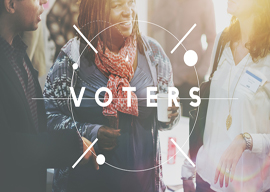
November 16, 2016

Source: Bigstock
As the Duke of Wellington more or less said after the Battle of Waterloo, it was a damn close-run thing. But the Trump campaign triumphed using what my editor at VDARE, Peter Brimelow, likes to call the Sailer Strategy.
As I explained 16 years ago during the Florida recount after the 2000 election, the reason George W. Bush was desperately hoping to win the Electoral College 271″267 was not that he had lost the nonwhite vote 77″21, but that he had won the white vote merely 54″42.
If Bush had earned 57 percent of whites, he would have captured the Electoral College 371″167.
But what if adding three more points among whites had cost Bush, say, eight points among nonwhites? Bush still would have won 310″228.
I asked in 2000:
So where could Bush have picked up an additional 3 percent of the white vote? The most obvious source: white union families.
How?
Immigration should be the perfect issue for the GOP to use to split the rank and file from their Democratic bosses. Since union efforts cost Bush Michigan, Pennsylvania, and Wisconsin (at a minimum), you”d think that the GOP would be hot to win back the Reagan Democrats. Don”t count on it, though. It’s just so much more fashionable to continue to chase futilely after Hispanics.
But my arithmetic was terribly out of fashion in the GOP for most of the 21st century. After all, working-class Americans in the North were the traditional enemy. It was much more appealing to Republican strategists to fantasize about bribing Latino newcomers by letting in more of their relatives than to work out a modus vivendi among white-collar and blue-collar Americans.
So the GOP establishment invested immensely in their strategy of converting Hispanics into home-owning Republicans. George W. Bush’s 2002″04 push for Minority Homeownership by signaling to subprime lenders that federal regulators would no longer harass them about traditional mortgage credit standards such as down payments and documentation set off the housing bubble in the Sand States of California, Arizona, Nevada, and Florida.
This boosted Bush to a mere 58″40 loss among Hispanics in 2004.
But when the Bush bubble burst in 2008, taking the world economy down with it, Hispanics, who defaulted disproportionately on mortgages, turned against John McCain 67″31, even though he had cosponsored the failed 2006 amnesty bill with Ted Kennedy.
It took only a decade and a half, but Donald Trump won Michigan, Pennsylvania, and Wisconsin, not to mention Ohio, Iowa, and the White House.
Right after the 2012 election, I pointed out that in those five states, plus Minnesota, which Trump narrowly lost, Romney had won only 52 percent of the white vote. That was six points worse than Romney did nationally.
Most notably, Romney did terribly among the white working class in these six states. Thus he did only two points worse among whites with college degrees in the Slippery Six than he did nationally. But among the white “some college” component, he came in six points worse than nationally. And among the white “no college” voters, he performed 11 points worse than across the country”finishing tied with Obama.
In contrast, in 2016 Trump won 64 percent of whites in Ohio (among voters for the two main parties), 61 percent in Michigan, 58 percent in Pennsylvania, 57 percent in Iowa, and 57 percent in Wisconsin, giving him 70 incremental electoral votes over Romney’s performance. (Minnesota slipped through Trump’s fingers because he carried only 54 percent of the two-party vote there.)
Strikingly, Trump was also able to win Florida by winning 67 percent of whites among Floridians who voted for Clinton or Trump. It turns out that the media’s assumption that the Cubans and Puerto Ricans of Florida care passionately about amnesty for Mesoamericans out of ethnic solidarity isn”t all that true. Granted, Trump won only 36 percent of the Hispanic vote in Florida, but Florida Latinos didn”t turn out in tidal-wave proportions.
Across the country, Trump didn”t pay much of a price for his skepticism about immigration. He did slightly worse than McCain among Hispanics and Asian voters, but slightly better than Romney.
In general, Hispanics and Asians tend to follow their white neighbors, just well to the left. In conservative states, voters who aren”t black or white tend to be centrist, while in liberal states they are leftists.
For example, it’s widely stated in the press that the reason Republicans do worse among Hispanics in California (where Trump won 25 percent of the Hispanic vote) than in Texas (36 percent) is due to the poisonous heritage of Republican California governor Pete Wilson endorsing Proposition 187 in 1994.
In reality, however, the GOP does fairly well among California Latinos relative to how horribly the party does among California whites (47 percent). In Texas, in contrast, Trump won 73 percent of the white vote without even trying in a state where, as the ultimate New Yorker, Trump isn”t really that personally appealing (to judge from old King of the Hill episodes).
Among blacks, Trump did just enough to get by. He got crushed among black women 94″4, but black guys are fond enough of Trump that his 80″13 loss on light turnout could have been worse. For example, guessing from Dave Chappelle’s turn hosting Saturday Night Live right after the election, the independent-minded comedian may or may not have voted for Trump, but he probably didn”t inflict upon himself the humiliation of voting for Hillary.